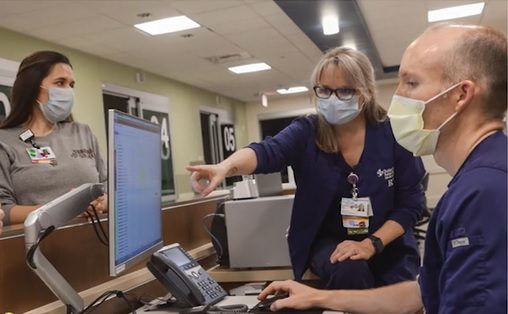When you book a hotel, pick a restaurant or buy products online, you can review star ratings from other consumers. Did you know that there is also a national star-rating systems for hospitals?
Since 2016, the Centers for Medicare & Medicaid Services (CMS) has assigned star ratings to hospitals across the country. The rating system helps people gather more information as they make choices about non-emergency hospital-based care, like scheduled surgeries and procedures. Hospitals that perform better on standard measures of quality, including readmission rates, safety and patient experience receive more stars; on average hospitals receive three stars, but high-performers can earn four or five.
CMS recently updated many hospitals star ratings, but what do the stars mean? Here are three things to know:
The ratings reflect care pre-pandemic. The updated hospital ratings evaluate care provided prior to March 31, 2020, before COVID-19 was widespread in the U.S. While CMS made this decision to ease paperwork burden during a demanding time, it also means that the remarkable work of hospitals and care teams to save lives isn’t entirely reflected.
“Sutter Health supports quality summaries like the CMS hospital star ratings, which reflect single points in time. Real-time data also helps us in our efforts to continuously improve care, increase safety and provide better outcomes for patients,” said William Isenberg, M.D., Ph.D., Sutter Health’s chief quality and safety officer.
Sutter-affiliated hospitals were able to cut the average time COVID patients were hospitalized from 20 days to just 8 days by working together to track data on patients and learn what treatments helped people recover faster. “This kind of rapid discovery and uptake of best practices, across all of our hospitals, and to the benefit of patients, is really the epitome of quality improvement,” Dr. Isenberg said.
The ratings reflect multiple aspects of quality. The Overall Hospital Quality Star Rating summarizes nearly 50 measures of healthcare quality for a given hospital, but some have greater emphasis. Four heavily weighted categories ― patient experience, safety, readmission and mortality ― account for more than 80% of a hospital’s overall star rating.
“Hospitals have different strengths; one might be excellent in helping patients avoid readmission while another might be excellent in patient experience,” Dr. Isenberg said. “So even while the CMS endeavors to provide an overall rating, it recognizes that achievements in individual categories play an important role too.”
Overall, 86% of Sutter-affiliated hospital campuses earned ratings of five, four or three stars in the recent update. Across the 21 hospitals in the not-for-profit network that were rated, the average rating was 3.76 stars.
The ratings aren’t meant for emergency decisions. The CMS hospital ratings can be thought of as a jumping off point for making decisions about care you can plan for, but they shouldn’t be consulted if doing so would delay accessing care in an emergency.
“In an emergency, you should always go to the nearest hospital,” Dr. Isenberg said.
Additionally, CMS overall hospital star ratings should be considered alongside other factors, like your doctor’s guidance about which hospitals can accommodate personalized needs. All ratings are available at www.medicare.gov/hospitalcompare.
Note: This content is not intended to be a substitute for professional medical advice, diagnosis or treatment. Always seek the advice of your physician or other qualified health provider with any questions you may have regarding a medical condition. Never disregard professional medical advice or delay in seeking it because of something you have read on this website.





